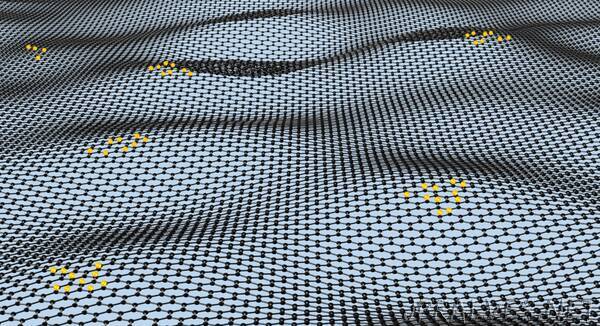
“A team of researchers led by Prof. Andre Geim from the National Graphene Institute (NGI) have discovered that nanoripples in graphene can make it a strong catalyst, contrary to general expectations that the carbon sheet is as chemically inert as the bulk graphite from which it is obtained.
Published this week in the Proceedings of the National Academy of Sciences (PNAS), the research has shown that graphene with nanoscale corrugations of its surface can accelerate hydrogen splitting as well as the best metallic-based catalysts. This unexpected effect is likely to be present in all two-dimensional materials, which are all inherently non-flat.
The Manchester team in collaboration with researchers from China and USA conducted a series of experiments to show that non-flatness of graphene makes it a strong catalyst. First, using ultrasensitive gas flow measurements and Raman spectroscopy, they demonstrated that graphene’s nanoscale corrugations were linked to its chemical reactivity with molecular hydrogen (H2) and that the activation energy for its dissociation into atomic hydrogen (H) was relatively small.
The team evaluated whether this reactivity is enough to make the material an efficient catalyst. To this end, the researchers used a mixture of hydrogen and deuterium (D2) gases and found that graphene indeed behaved as a powerful catalyst, converting H2 and D2 into HD. This was in stark contrast to the behaviour of graphite and other carbon-based materials under the same conditions. The gas analyses revealed that the amount of HD generated by monolayer graphene was approximately the same as for the known hydrogen catalysts, such as zirconia, magnesium oxide and copper, but graphene was required only in tiny quantities, less than 100 times of the latter catalysts.
“Our paper shows that freestanding graphene is quite different from both graphite and atomically flat graphene that are chemically extremely inert. We have also proved that nanoscale corrugations are more important for catalysis than the ‘usual suspects’ such as vacancies, edges and other defects on graphene’s surface” said Dr Pengzhan Sun, first author of the paper.
Lead author of the paper Prof. Geim added, “As nanorippling naturally occurs in all atomically thin crystals, because of thermal fluctuations and unavoidable local mechanical strain, other 2D materials may also show similarly enhanced reactivity. As for graphene, we can certainly expect it to be catalytically and chemically active in other reactions, not only those involving hydrogen.”
“2D materials are most often perceived as atomically flat sheets, and effects caused by unavoidable nanoscale corrugations have so far been overlooked. Our work shows that those effects can be dramatic, which has important implications for the use of 2D materials. For example, bulk molybdenum sulphide and other chalcogenides are often employed as 3D catalysts. Now we should wonder if they could be even more active in their 2D form”.”
